Motivating Employees: Theories, Feedback, and the SPIRIT Framework
VerifiedAdded on 2023/06/15
|6
|1004
|391
Report
AI Summary
This report provides a comprehensive overview of employee motivation, highlighting its importance and the role of managers as motivators. It discusses the significance of orientation and onboarding processes, emphasizing how they contribute to employee satisfaction and productivity. The report also explores the SPIRIT framework for setting organizational goals, stressing the importance of specific, incentivized, individual-focused, reviewed, inspiring, and time-bound objectives. Furthermore, it underscores the role of feedback in maintaining a motivational climate and explains the reinforcement theory of motivation, illustrating how positive and negative consequences influence employee behavior. The document concludes by referencing relevant literature on the subject, providing a well-rounded perspective on motivating employees in the workplace. Desklib offers a platform to explore more solved assignments.

MOTIVATING
EMPLOYEES
EMPLOYEES
Paraphrase This Document
Need a fresh take? Get an instant paraphrase of this document with our AI Paraphraser
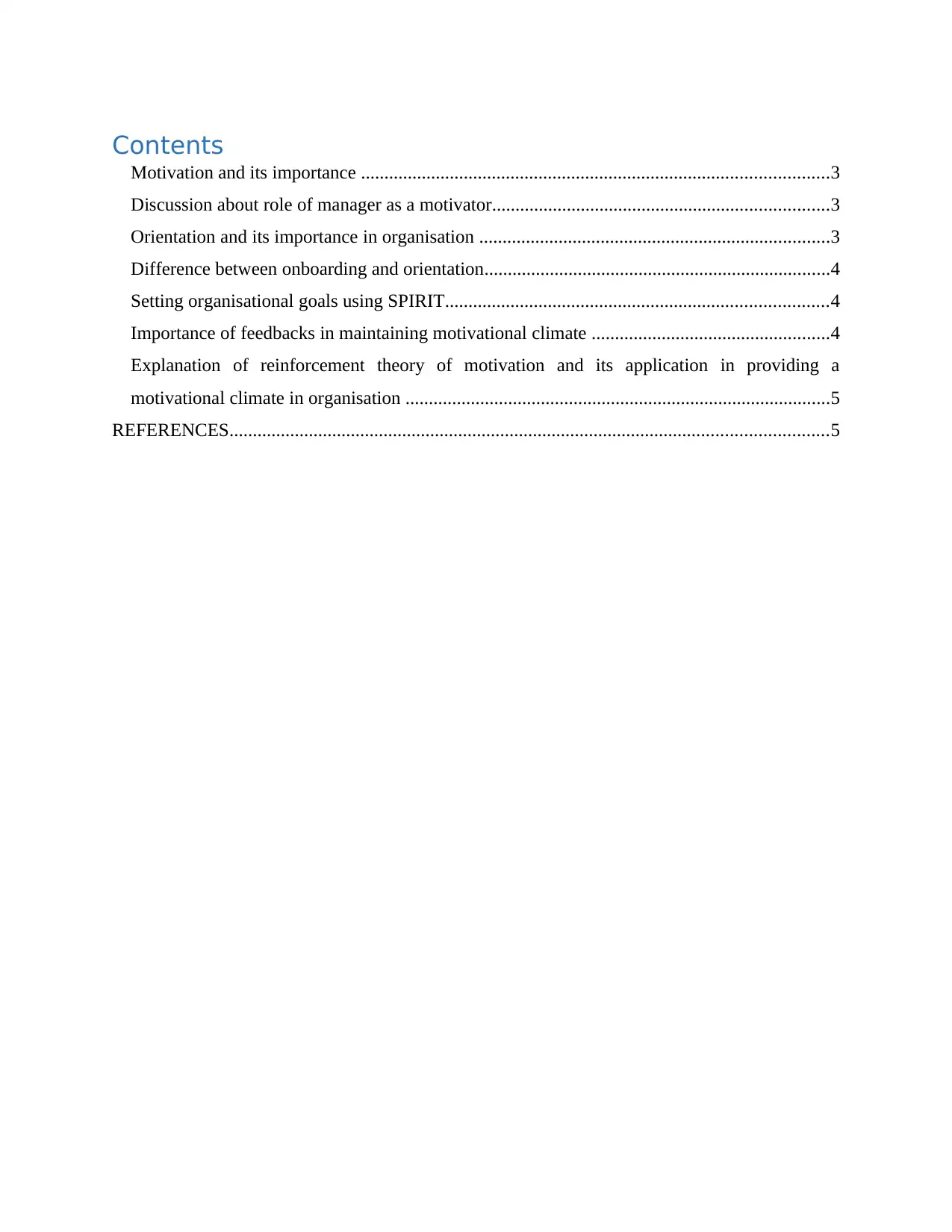
Contents
Motivation and its importance ....................................................................................................3
Discussion about role of manager as a motivator........................................................................3
Orientation and its importance in organisation ...........................................................................3
Difference between onboarding and orientation..........................................................................4
Setting organisational goals using SPIRIT..................................................................................4
Importance of feedbacks in maintaining motivational climate ...................................................4
Explanation of reinforcement theory of motivation and its application in providing a
motivational climate in organisation ...........................................................................................5
REFERENCES................................................................................................................................5
Motivation and its importance ....................................................................................................3
Discussion about role of manager as a motivator........................................................................3
Orientation and its importance in organisation ...........................................................................3
Difference between onboarding and orientation..........................................................................4
Setting organisational goals using SPIRIT..................................................................................4
Importance of feedbacks in maintaining motivational climate ...................................................4
Explanation of reinforcement theory of motivation and its application in providing a
motivational climate in organisation ...........................................................................................5
REFERENCES................................................................................................................................5
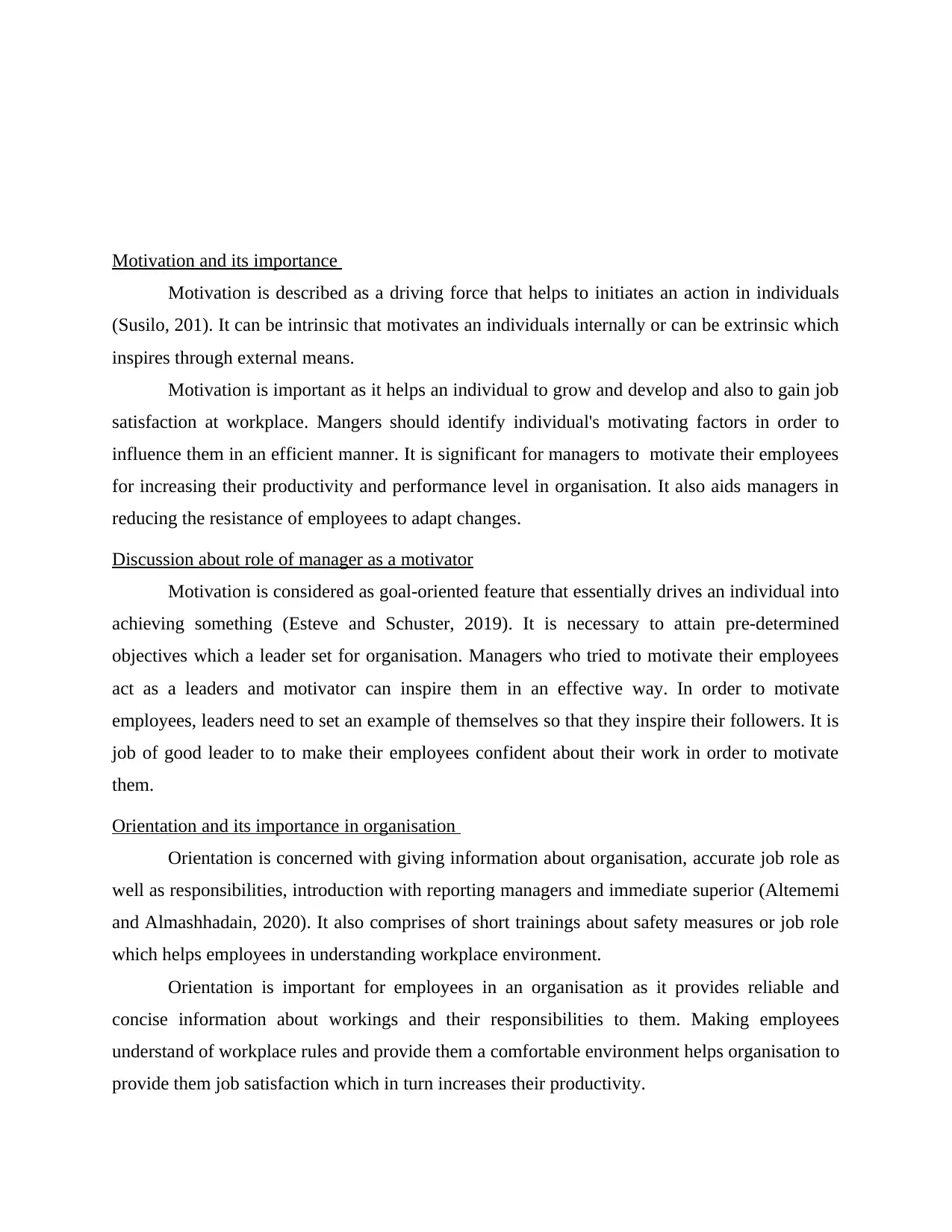
Motivation and its importance
Motivation is described as a driving force that helps to initiates an action in individuals
(Susilo, 201). It can be intrinsic that motivates an individuals internally or can be extrinsic which
inspires through external means.
Motivation is important as it helps an individual to grow and develop and also to gain job
satisfaction at workplace. Mangers should identify individual's motivating factors in order to
influence them in an efficient manner. It is significant for managers to motivate their employees
for increasing their productivity and performance level in organisation. It also aids managers in
reducing the resistance of employees to adapt changes.
Discussion about role of manager as a motivator
Motivation is considered as goal-oriented feature that essentially drives an individual into
achieving something (Esteve and Schuster, 2019). It is necessary to attain pre-determined
objectives which a leader set for organisation. Managers who tried to motivate their employees
act as a leaders and motivator can inspire them in an effective way. In order to motivate
employees, leaders need to set an example of themselves so that they inspire their followers. It is
job of good leader to to make their employees confident about their work in order to motivate
them.
Orientation and its importance in organisation
Orientation is concerned with giving information about organisation, accurate job role as
well as responsibilities, introduction with reporting managers and immediate superior (Altememi
and Almashhadain, 2020). It also comprises of short trainings about safety measures or job role
which helps employees in understanding workplace environment.
Orientation is important for employees in an organisation as it provides reliable and
concise information about workings and their responsibilities to them. Making employees
understand of workplace rules and provide them a comfortable environment helps organisation to
provide them job satisfaction which in turn increases their productivity.
Motivation is described as a driving force that helps to initiates an action in individuals
(Susilo, 201). It can be intrinsic that motivates an individuals internally or can be extrinsic which
inspires through external means.
Motivation is important as it helps an individual to grow and develop and also to gain job
satisfaction at workplace. Mangers should identify individual's motivating factors in order to
influence them in an efficient manner. It is significant for managers to motivate their employees
for increasing their productivity and performance level in organisation. It also aids managers in
reducing the resistance of employees to adapt changes.
Discussion about role of manager as a motivator
Motivation is considered as goal-oriented feature that essentially drives an individual into
achieving something (Esteve and Schuster, 2019). It is necessary to attain pre-determined
objectives which a leader set for organisation. Managers who tried to motivate their employees
act as a leaders and motivator can inspire them in an effective way. In order to motivate
employees, leaders need to set an example of themselves so that they inspire their followers. It is
job of good leader to to make their employees confident about their work in order to motivate
them.
Orientation and its importance in organisation
Orientation is concerned with giving information about organisation, accurate job role as
well as responsibilities, introduction with reporting managers and immediate superior (Altememi
and Almashhadain, 2020). It also comprises of short trainings about safety measures or job role
which helps employees in understanding workplace environment.
Orientation is important for employees in an organisation as it provides reliable and
concise information about workings and their responsibilities to them. Making employees
understand of workplace rules and provide them a comfortable environment helps organisation to
provide them job satisfaction which in turn increases their productivity.
⊘ This is a preview!⊘
Do you want full access?
Subscribe today to unlock all pages.

Trusted by 1+ million students worldwide
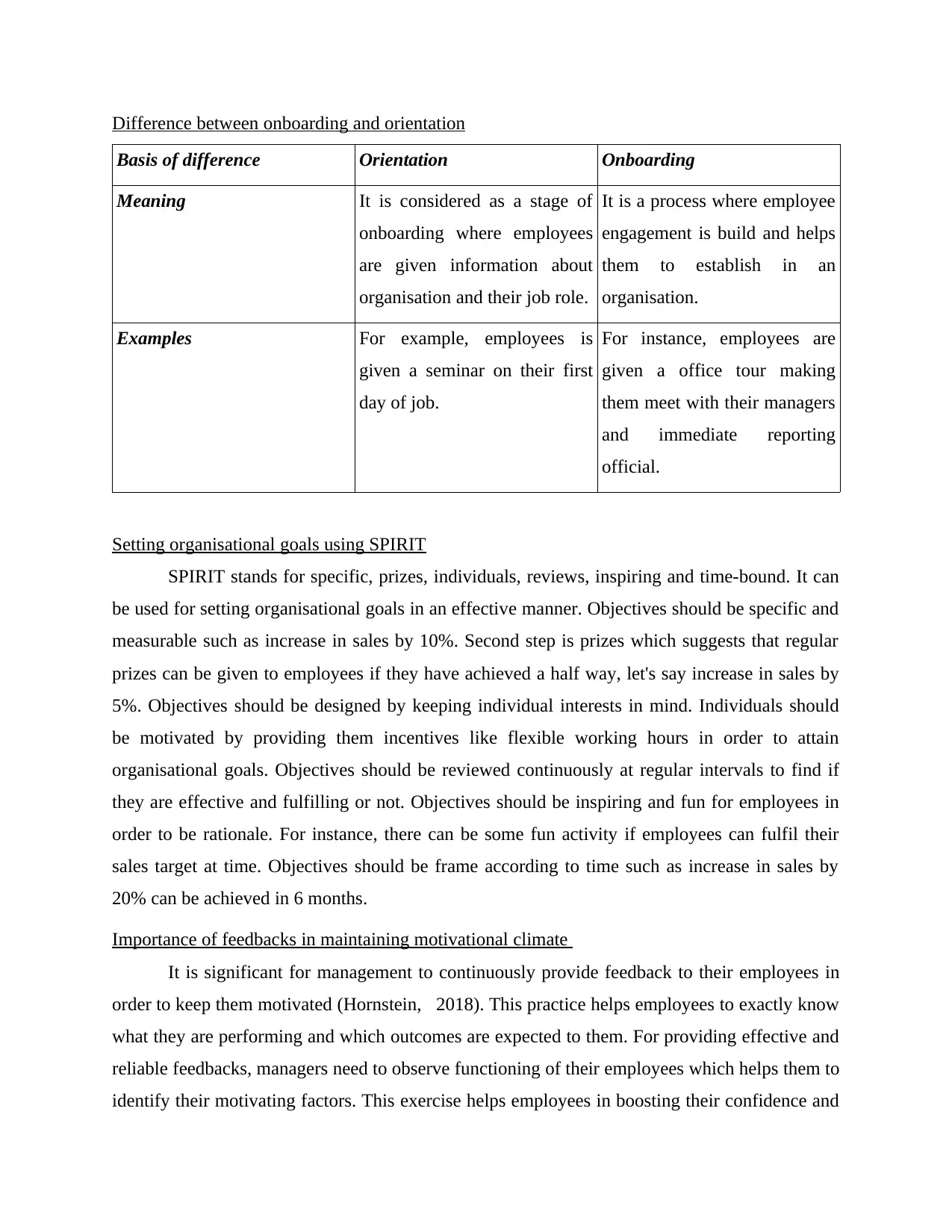
Difference between onboarding and orientation
Basis of difference Orientation Onboarding
Meaning It is considered as a stage of
onboarding where employees
are given information about
organisation and their job role.
It is a process where employee
engagement is build and helps
them to establish in an
organisation.
Examples For example, employees is
given a seminar on their first
day of job.
For instance, employees are
given a office tour making
them meet with their managers
and immediate reporting
official.
Setting organisational goals using SPIRIT
SPIRIT stands for specific, prizes, individuals, reviews, inspiring and time-bound. It can
be used for setting organisational goals in an effective manner. Objectives should be specific and
measurable such as increase in sales by 10%. Second step is prizes which suggests that regular
prizes can be given to employees if they have achieved a half way, let's say increase in sales by
5%. Objectives should be designed by keeping individual interests in mind. Individuals should
be motivated by providing them incentives like flexible working hours in order to attain
organisational goals. Objectives should be reviewed continuously at regular intervals to find if
they are effective and fulfilling or not. Objectives should be inspiring and fun for employees in
order to be rationale. For instance, there can be some fun activity if employees can fulfil their
sales target at time. Objectives should be frame according to time such as increase in sales by
20% can be achieved in 6 months.
Importance of feedbacks in maintaining motivational climate
It is significant for management to continuously provide feedback to their employees in
order to keep them motivated (Hornstein, 2018). This practice helps employees to exactly know
what they are performing and which outcomes are expected to them. For providing effective and
reliable feedbacks, managers need to observe functioning of their employees which helps them to
identify their motivating factors. This exercise helps employees in boosting their confidence and
Basis of difference Orientation Onboarding
Meaning It is considered as a stage of
onboarding where employees
are given information about
organisation and their job role.
It is a process where employee
engagement is build and helps
them to establish in an
organisation.
Examples For example, employees is
given a seminar on their first
day of job.
For instance, employees are
given a office tour making
them meet with their managers
and immediate reporting
official.
Setting organisational goals using SPIRIT
SPIRIT stands for specific, prizes, individuals, reviews, inspiring and time-bound. It can
be used for setting organisational goals in an effective manner. Objectives should be specific and
measurable such as increase in sales by 10%. Second step is prizes which suggests that regular
prizes can be given to employees if they have achieved a half way, let's say increase in sales by
5%. Objectives should be designed by keeping individual interests in mind. Individuals should
be motivated by providing them incentives like flexible working hours in order to attain
organisational goals. Objectives should be reviewed continuously at regular intervals to find if
they are effective and fulfilling or not. Objectives should be inspiring and fun for employees in
order to be rationale. For instance, there can be some fun activity if employees can fulfil their
sales target at time. Objectives should be frame according to time such as increase in sales by
20% can be achieved in 6 months.
Importance of feedbacks in maintaining motivational climate
It is significant for management to continuously provide feedback to their employees in
order to keep them motivated (Hornstein, 2018). This practice helps employees to exactly know
what they are performing and which outcomes are expected to them. For providing effective and
reliable feedbacks, managers need to observe functioning of their employees which helps them to
identify their motivating factors. This exercise helps employees in boosting their confidence and
Paraphrase This Document
Need a fresh take? Get an instant paraphrase of this document with our AI Paraphraser
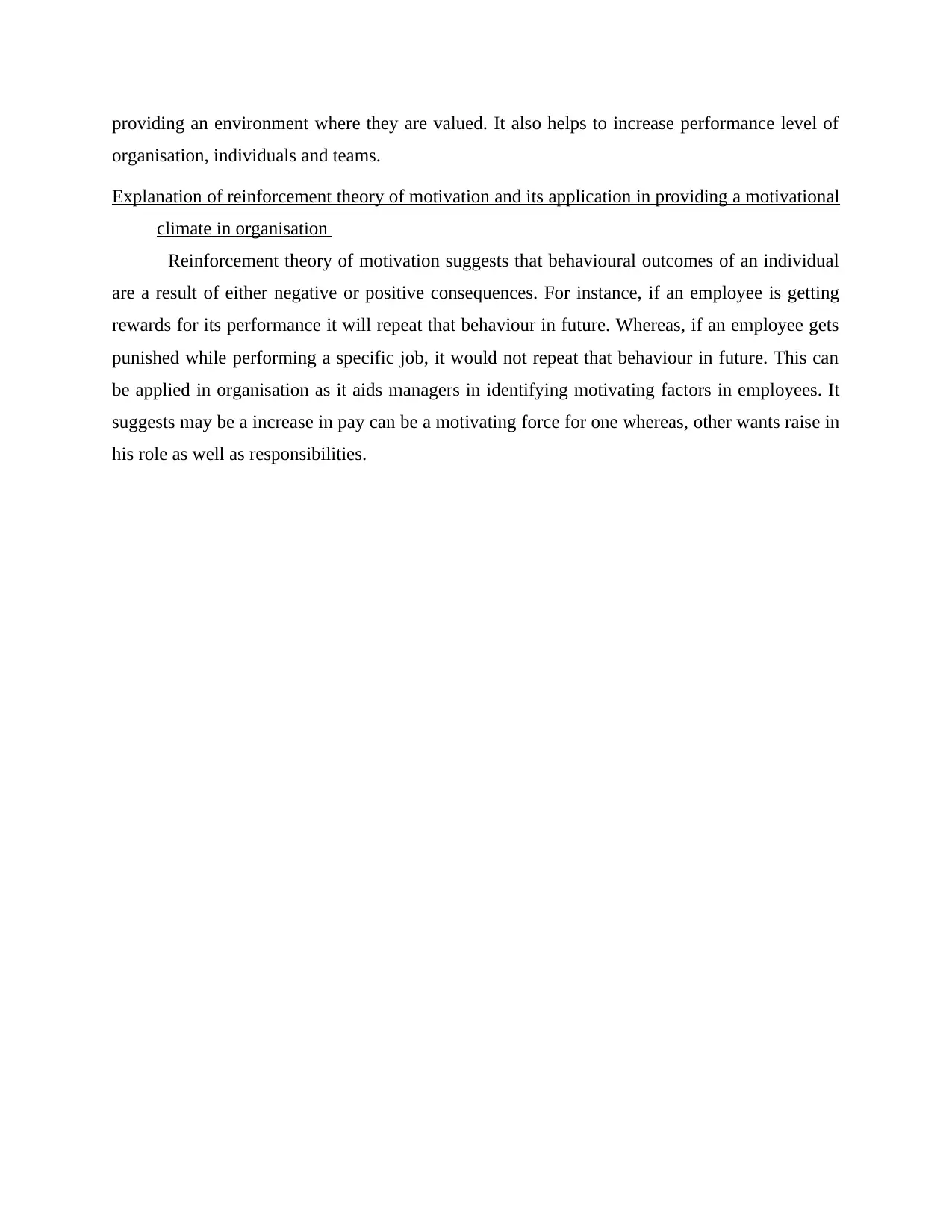
providing an environment where they are valued. It also helps to increase performance level of
organisation, individuals and teams.
Explanation of reinforcement theory of motivation and its application in providing a motivational
climate in organisation
Reinforcement theory of motivation suggests that behavioural outcomes of an individual
are a result of either negative or positive consequences. For instance, if an employee is getting
rewards for its performance it will repeat that behaviour in future. Whereas, if an employee gets
punished while performing a specific job, it would not repeat that behaviour in future. This can
be applied in organisation as it aids managers in identifying motivating factors in employees. It
suggests may be a increase in pay can be a motivating force for one whereas, other wants raise in
his role as well as responsibilities.
organisation, individuals and teams.
Explanation of reinforcement theory of motivation and its application in providing a motivational
climate in organisation
Reinforcement theory of motivation suggests that behavioural outcomes of an individual
are a result of either negative or positive consequences. For instance, if an employee is getting
rewards for its performance it will repeat that behaviour in future. Whereas, if an employee gets
punished while performing a specific job, it would not repeat that behaviour in future. This can
be applied in organisation as it aids managers in identifying motivating factors in employees. It
suggests may be a increase in pay can be a motivating force for one whereas, other wants raise in
his role as well as responsibilities.
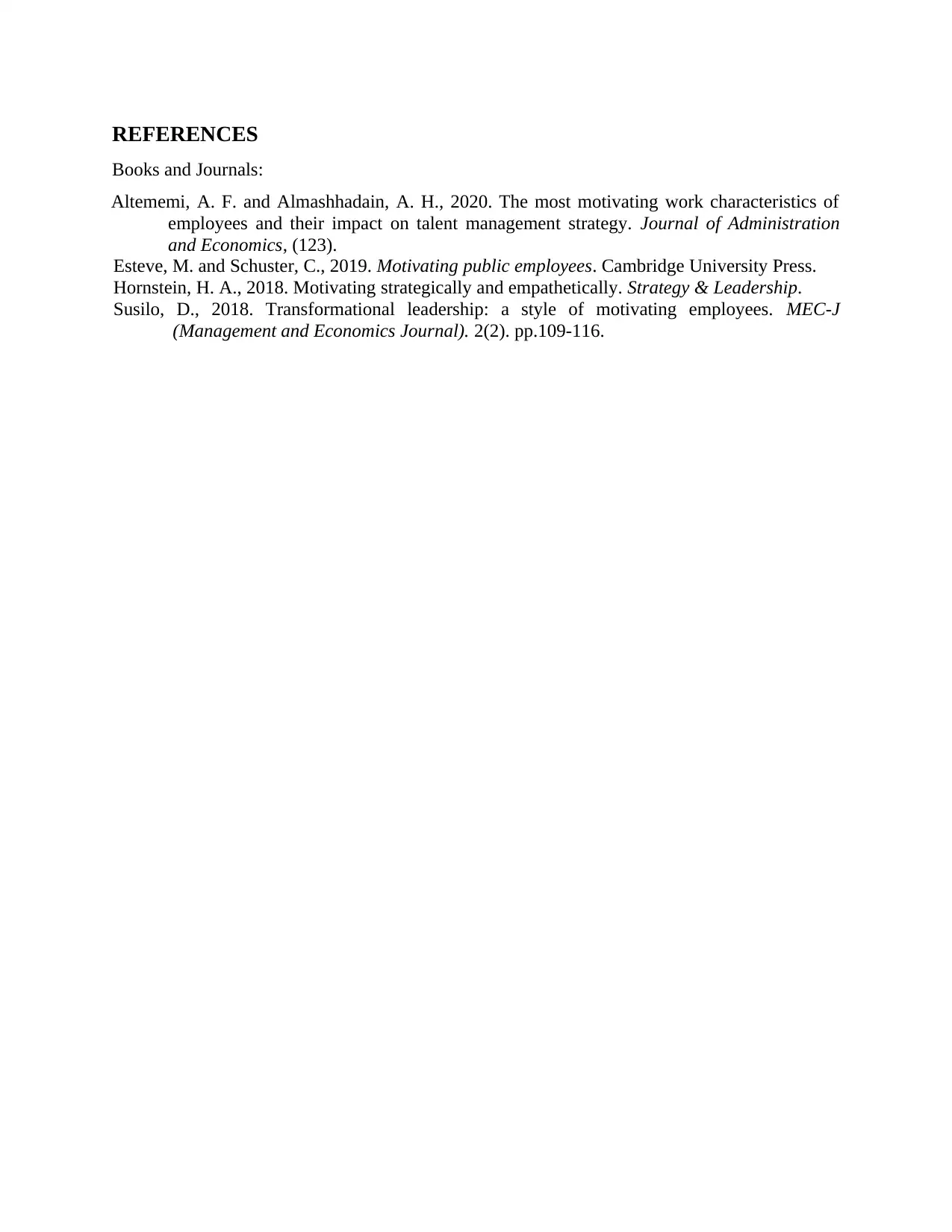
REFERENCES
Books and Journals:
Altememi, A. F. and Almashhadain, A. H., 2020. The most motivating work characteristics of
employees and their impact on talent management strategy. Journal of Administration
and Economics, (123).
Esteve, M. and Schuster, C., 2019. Motivating public employees. Cambridge University Press.
Hornstein, H. A., 2018. Motivating strategically and empathetically. Strategy & Leadership.
Susilo, D., 2018. Transformational leadership: a style of motivating employees. MEC-J
(Management and Economics Journal). 2(2). pp.109-116.
Books and Journals:
Altememi, A. F. and Almashhadain, A. H., 2020. The most motivating work characteristics of
employees and their impact on talent management strategy. Journal of Administration
and Economics, (123).
Esteve, M. and Schuster, C., 2019. Motivating public employees. Cambridge University Press.
Hornstein, H. A., 2018. Motivating strategically and empathetically. Strategy & Leadership.
Susilo, D., 2018. Transformational leadership: a style of motivating employees. MEC-J
(Management and Economics Journal). 2(2). pp.109-116.
⊘ This is a preview!⊘
Do you want full access?
Subscribe today to unlock all pages.

Trusted by 1+ million students worldwide
1 out of 6
Related Documents
Your All-in-One AI-Powered Toolkit for Academic Success.
+13062052269
info@desklib.com
Available 24*7 on WhatsApp / Email
![[object Object]](/_next/static/media/star-bottom.7253800d.svg)
Unlock your academic potential
Copyright © 2020–2025 A2Z Services. All Rights Reserved. Developed and managed by ZUCOL.





